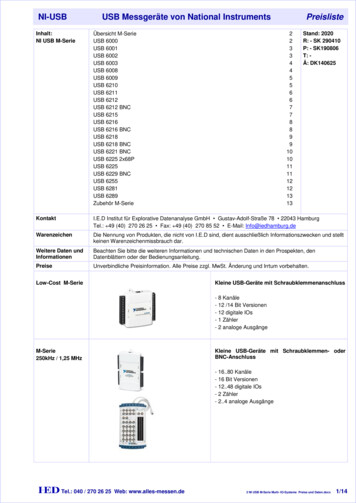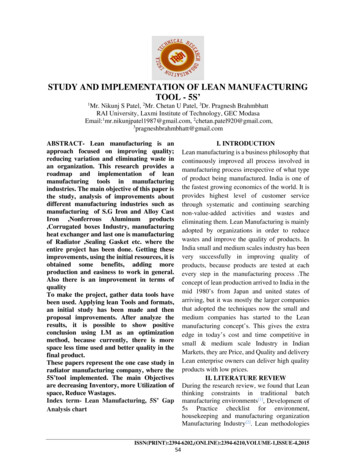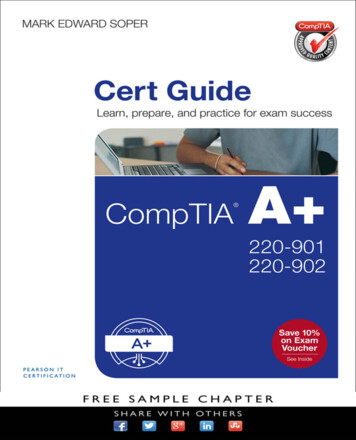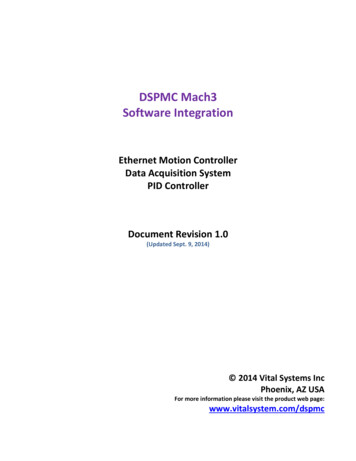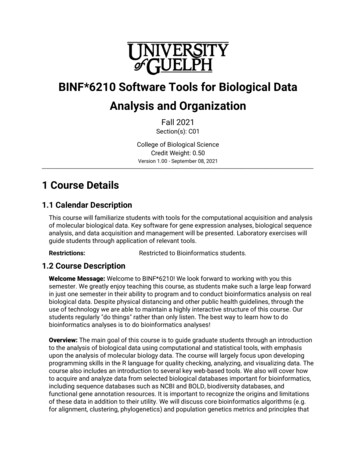
Transcription
BINF*6210 Software Tools for Biological DataAnalysis and OrganizationFall 2021Section(s): C01College of Biological ScienceCredit Weight: 0.50Version 1.00 - September 08, 20211 Course Details1.1 Calendar DescriptionThis course will familiarize students with tools for the computational acquisition and analysisof molecular biological data. Key software for gene expression analyses, biological sequenceanalysis, and data acquisition and management will be presented. Laboratory exercises willguide students through application of relevant tools.Restrictions:Restricted to Bioinformatics students.1.2 Course DescriptionWelcome Message: Welcome to BINF*6210! We look forward to working with you thissemester. We greatly enjoy teaching this course, as students make such a large leap forwardin just one semester in their ability to program and to conduct bioinformatics analysis on realbiological data. Despite physical distancing and other public health guidelines, through theuse of technology we are able to maintain a highly interactive structure of this course. Ourstudents regularly "do things" rather than only listen. The best way to learn how to dobioinformatics analyses is to do bioinformatics analyses!Overview: The main goal of this course is to guide graduate students through an introductionto the analysis of biological data using computational and statistical tools, with emphasisupon the analysis of molecular biology data. The course will largely focus upon developingprogramming skills in the R language for quality checking, analyzing, and visualizing data. Thecourse also includes an introduction to several key web-based tools. We also will cover howto acquire and analyze data from selected biological databases important for bioinformatics,including sequence databases such as NCBI and BOLD, biodiversity databases, andfunctional gene annotation resources. It is important to recognize the origins and limitationsof these data in addition to their utility. We will discuss core bioinformatics algorithms (e.g.for alignment, clustering, phylogenetics) and population genetics metrics and principles that
BINF*6210 C01 F21 v1.00are important for making analytical decisions and interpreting results. We also will promotegood practices for organizing your data and analyses, preparing reproducible analyses, andwriting well-commented code, and will introduce software tools that facilitate version controland collaborative coding. As bioinformatics is a fast-moving discipline, we will also spendtime practising strategies for how to learn to use new tools and to conduct new analyses.Curriculum Note: This course is complementary to others in the bioinformatics graduateprogram. In the fall semester of 2021, programming in the Unix environment and in thePython language are covered in Bioinformatics Programming (BINF*6410). Students in theMaster of Bioinformatics program must also take Topics in Bioinformatics (BINF*6890),which covers diverse concepts in bioinformatics and emphasizes critical thinking andcommunication skills. Key topics for this year include molecular phylogenetics, introductionto machine learning, and proteomics. The winter semester core bioinformatics courses areGenomic Methods (BINF*6110), in which large-scale genomic analysis and high-performancecomputing are covered, and Statistical Bioinformatics (BINF*6970). Students from othergraduate programs may wish to discuss their background and the suitability of these courseswith the instructors prior to enrolling.Pre-Requisites: Students accepted into the Master of Bioinformatics and MSc inBioinformatics programs should have the necessary background for this course. Whileprogramming experience (in any language) is helpful, no prior programming experience isassumed. Students are expected to have taken at least one course at the undergraduate levelin genetics or molecular biology as well as at least one course in statistics or biostatistics (orhave the equivalent experience).Course Format: Given the current pandemic situation and the time needed for some studentsto meet the vaccine mandate, this course will commence in remote instruction format, usingZoom. If the public health situation permits, the course will convert to hybrid format startingSept. 30th. To make this course as accessible as possible and to pandemic-proof the coursein light of possible changes in the public health situation, we will continue using Zoom so thatstudents can join, whether in class or remotely, regardless of their personal circumstances.1.3 TimetableWhere: Instruction will commence in remote format (September 9-28), with Zoom accessinstructions provided through the CourseLink site. After that time, and public health situationpermitting, the course will continue using Zoom and students may join in either MCKN, Room237 on campus or remotely.When: Tuesdays and Thursdays 11:30 AM - 12:50 PM Eastern time. September 9 - December2, 2021,(Note: There is no class on Tuesday October 12 for the Fall Study Break.)1.4 Final ExamThere is no final exam for this course.Page 2 of 16
BINF*6210 C01 F21 v1.002 Instructional Support2.1 Instructional Support TeamInstructor:Email:Telephone:Office:Office Hours:Dr. Sarah Adamowicz Associate Professor, Department ofIntegrative Biologysadamowi@uoguelph.ca 1-519-824-4120 x53055SSC 2447Office Hour: Tuesdays 1:15 - 2:15 PM from September 14 November 30, 2021 (except October 12).For the benefit of all class members, I encourage students toask questions during class time and to post generalquestions about course content and the assignments to theDiscussion board through CourseLink.Students are also encouraged to attend Tuesday OfficeHour for individual questions.2.2 Teaching AssistantsTeaching Assistant (GTA):Email:Office Hours:Jacqueline May MSc in Bioinformatics, PhD in BioinformaticsCandidatemayj@uoguelph.caStudents will benefit from interaction and instruction fromTeaching Assistant Jacqueline May, a fourth-year PhDstudent. Please email Jacqueline for an appointment.3 Learning Resources3.1 Required ResourcesR and RStudio (Software)Prior to the first class, please install R on your computer:https://www.r-project.org/Prior to the second class, please install RStudio:https://www.rstudio.com/Announcements will be made throughout the semester regarding R packages or additionalsoftware to install prior to the next class.Page 3 of 16
BINF*6210 C01 F21 v1.00Papers and Textbook Chapters (Readings)Relevant published articles related to the course content for each day will be postedthrough CourseLink. The first-listed article for each class is required reading for that class.The other posted readings are recommended or supplemental for students interested inmore depth on that topic.We will also be consulting a wide range of online resources, such as software manuals andvignettes for Bioconductor packages. Links to relevant resources will be posted in theclass slides and in the comments sections of the example code.Additionally, selected chapters from the following manuals and books will berecommended to accompany specific modules. All are available as open-access PDFsdirectly online or are available as a PDF book for download through the University of Guelphlibrary site (https://www.lib.uoguelph.ca/).1. Paradis E, 2005. R For Beginners. (Freely available through the following s-rdebuts en.pdf)2. Wickham H & Grolemund G, 2017. R for Data Science. O’Reilly. (Freely available through:http://r4ds.had.co.nz/)3. Xia X, 2018. Bioinformatics and the Cell: Modern Computational Approaches inGenomics, Proteomics and Transcriptomics. Second Edition. Springer. (Available throughthe library)4 Learning Outcomes4.1 Course Learning OutcomesBy the end of this course, you should be able to:1. obtain data from key databases relevant for bioinformatics and to understandthe sources and limitations of these data.2. filter, manipulate, analyze, and visualize bioinformatics data, with emphasison the R programming language and software resources available throughBioconductor.3. conduct reproducible analyses and use software tools for version control andcollaboration.Page 4 of 16
BINF*6210 C01 F21 v1.004. understand and apply selected algorithms commonly used in bioinformatics,including for sequence alignment and clustering.5. adapt the above skills to learn new tools and conduct new analyses notexplicitly covered in class.5 Teaching and Learning Activities5.1 LectureThu, Sep 9 - Thu, Dec 2Topics:This course consists of both asynchronouscomponents (which you complete at your own pace inadvance of class) and synchronous activities (i.e.conducted during our scheduled class time).Each week, course materials will be uploaded toCourseLink for students to complete in advance ofclass. This will typically include a pre-recorded lecture ortutorial. Many weeks, there will also be one ortwo commented R scripts provided for students to gothrough at your own pace. There is also a requiredreading associated with each class.5.2 LabThu, Sep 9 - Thu, Dec 2Topics:The course also involves synchronous activitiesperformed during class time (11:30 AM - 12:50 PMTuesdays and Thursdays from Sept 9 - Dec 2; no classOct 12). Our "computer lab" activities will take placeremotely Sept 9-28, enabled by technology. You willneed a laptop and internet connection. Starting Sept 30,and public health situation permitting, students may jointhe class either in the classroom or remotely.Page 5 of 16
BINF*6210 C01 F21 v1.00During class time, after a short introduction, we willfocus upon interactive learning activities, includingcritical thinking exercises, solving coding challenges,and sometimes even games. During many of theclasses, we will use technology to form small "break-outgroups" to enable small groups to work together forselected active learning exercises, with the Instructorand Teaching Assistant rotating among groups. Wethen come together again as a complete class todiscuss the exercise and to address questions fromclass members.5.3 TopicsYou will find here the planned schedule of topics. Minor adjustments may be madethroughout the semester, such as based upon the background and interests of classmembers or prospects for an interesting guest lecture. Any changes would be announcedthrough CourseLink.1 - Sept 9 - Introduction to Course and R2 - Sept 14 - RStudio and DNA barcoding3 - Sept 16 - BOLD and Biodiversity4 - Sept 21 - R Tips and Data Frames 15 - Sept 23 - Data Frames 26 - Sept 28 - Intro to tidyverse and R Game7 - Sept 30 - Graphing and ggplot2 package8 - Oct 5 - Bioconductor Biostrings k-mers9 - Oct 7 - R Markdown - randomForest10 - Oct 14 - Databases NCBI11 - Oct 19 - Sequence Alignment12 - Oct 21 - Clustering13 - Oct 26 - Phylogenetics14 - Oct 28 - GitHubPage 6 of 16
BINF*6210 C01 F21 v1.0015 - Nov 2 - Iteration Looping Pipelines16 - Nov 4 - Writing Functions in R17 - Nov 9 - Gene Expression Analysis18 - Nov 11 - TBD*19 - Nov 16 - Population Genetics20 - Nov 18 - data.table package21 - Nov 23 - Microbiome22 - Nov 25 - Imputation23 - Nov 30 - Relational Data and SQL24 - Dec 2 - Discuss Package Development and Course Synthesis*either guest lecture or topic voted most of interest to class, such as gene enrichmentanalysis or multivariate analysis6 AssessmentsOverview: There are 4 major and 1 minor assignment for this course. Detailed instructionsand a grading rubric for each assignment are posted to CourseLink. This course also includesa short weekly quiz to help you stay on track throughout the semester.Plagiarism: Please note that the TurnItIn tool will be used to assess the originality of yourwork in comparison to that of your peers and to internet sources. If a high match to onlinesources is detected, please note that we would check to see where the matches are. Weexpect exact matches to other sources for the assignment questions, to the references (e.g.journal article titles), and phrases that should be used exactly as in sources (e.g. longmolecule names). Additionally, you are permitted to adapt provided example computer scriptsfor your assignments, but you should also add some novel code. The amount of novel codewill increase throughout the semester. You should explain the commenting in your own words(what is your code doing and why are you doing it). Otherwise, be sure to phrase your work inyour own words, and be sure to give credit to others for ideas from the literature as well as toany online sources consulted for coding help.Quiz Grading and Due Dates: Missed quizzes will receive a grade of 0, and your best 10 of 12quizzes will be used for your quiz grade. There is no extension on quizzes unless ofexceptional circumstances influencing your academic performance for two or more weeks.Such exceptional circumstances must be discussed with the instructor. It is to youradvantage to attempt each quiz and learn along the way.Page 7 of 16
BINF*6210 C01 F21 v1.00Assignment Due Dates: Please submit your assignments to the labeled Dropbox folder by thedue date and time. The course instructors recognize that the pandemic has causedchallenges for many individuals, whether due to personal health, familial responsibilities,etc. Therefore, if you find that you cannot meet a deadline for an Assignment due to illness orcompassionate reasons, please contact the instructor to discuss your situation prior to thedeadline date (unless something beyond your control makes this impossible).No late penalty will be imposed in this case, and the instructor will discuss your situation withyou and what academic accommodation may be suitable.Final Project Due Date: Please note that the final project due date is a hard deadline forreceiving a grade for this course for the Fall 2021 Semester. This due date was selected togive you time to work on your project. Aim to complete a full project draft at least two days inadvance, and spend the last days on proofreading and refinement. If you need to miss thisdeadline due to illness or other exceptional personal circumstances, documentation needs tobe provided and you will receive a grade of INC (incomplete). Depending upon your individualcircumstance, we would then work together to set a revised due date, and you would receiveyour final course grade in the Winter 2022 semester.Learning through Doing: In this course, assignments are used not only for assessment. Theassignments are also designed to serve as important learning tools. You should work on yourassignments regularly. Do not leave these assignments to the night before the due date! Wehope that you enjoy working on a variety of small yet meaningful projects throughout thecourse and expressing your creativity.6.1 Assessment DetailsWeekly Online Quizzes (20%)Throughout the semester, there will be a weekly online quiz, available through CourseLink.Quizzes will cover topics such as key terms, concepts, and code syntax. There will be 12quizzes in total, and your best 10 will be used to calculate your quiz grade (2% valuationeach). While each quiz bears modest weighting, we encourage all class members to keepup with the quizzes as they will add up to 20% of your total course grade, and grades in theproject assignments are typically lower. Moreover, making a consistent weekly effort willhelp you to improve your knowledge and skills consistently throughout the semester andavoid stress at the end. You should view the pre-recorded course materials, read thereading, and attend class prior to attempting each week's quiz. These are "open book"quizzes. While completing the quiz, you may therefore consult all course materials as wellas online sources. You may complete each weekly quiz at your own pace, any time beforethe due date (5:00 PM Mondays). Quizzes not completed by the due date will receive agrade of 0 but will remain available for viewing. Whenever possible, we encourage classmembers to complete the quiz on Thursday after class or on Friday each week.Page 8 of 16
BINF*6210 C01 F21 v1.00Quizzes should be completed by 5:00 PM Eastern Time on Mondays, preferably earlier.Assignment #1 (15%)Date: Fri, Oct 8, 5:00 PMFor assignments #1 and #2, you will apply your knowledge to solve new problems. You willdesign and complete a mini-project that builds upon the skills and concepts covered untilthat point in the course. Example mini-projects will be provided.Code needs to be correct, do what it is meant to do (always check!), be well-commented,and reproducible. In your commenting, you should focus on being precise in yourexplanations of algorithms and functions.The assignment will include an introductoryparagraph and a short written summary at the end interpreting your findings. For thisassignment, you may, in part, correctly adapt provided example scripts. You willadditionally be assessed on the creativity and novelty of your mini-project in terms of goingbeyond the class materials.Throughout the semester, you will need to balance your time between courses. Eachassignment for Software Tools should be worked on regularly over a couple of weeks. Donot leave these assignments to the night before!Assignment #1 is due to the CourseLink Dropbox by 5:00 PM by Friday Oct. 8th.Assignment #2 (15%)Date: Fri, Oct 29, 5:00 PMSee above for the description of Assignment #1.Additionally, as the course progresses, you should aim to write code that is streamlined aswell as computationally efficient. Examples would include using vectorized functions in Rrather than repeating similar lines of code. You should also pay careful attention to thepreparation of your visualizations, considering whether the main message is conveyedclearly, ensuring that you have used informative labeling, checking that your colour andsymbol choices are clear and accessible, etc. The quality and sophistication of your workwill improve over the course of the semester.Assignment #2 is due to the CourseLink Dropbox folder by 5:00 PM by Friday October29th.Assignment #3 (Group Project) (15%)Date: Fri, Nov 19, 5:00 PMFor Assignment #3 (Group Project), you will swap code (from either Assignment #1 orAssignment #2) with a peer in your group. The assignment involves making improvementsto your peer's code and using GitHub to manage the collaboration and code edits. Youshould discuss the project together and may work on the code together. Each person willindividually prepare a short-write up about the code improvements and collaborationprocess, which is individually graded.(Why GitHub? GitHub is an important code repository as well as a tool for version controlPage 9 of 16
BINF*6210 C01 F21 v1.00and collaboration. By the end of your program, we would highly recommended that youpost examples of your work to GitHub and provide a link to your GitHub page on your CVwhen applying for bioinformatics-related jobs.)Assignment #3 is due to the CourseLink Dropbox folder by 5:00 PM by Friday November19th.Assignment #4 (Seminars) (5%)Date: Fri, Dec 3, 5:00 PMFor students registered in the Software Tools class, attendance at the BioinformaticsSeminar Series is mandatory. Seminars will be held in virtual format for the Fall 2021semester. Attendance in real time is preferred to the maximum degree possible, to enableaudience members to ask questions and to interact with members of the communityafterwards. However, the seminars will be recorded for those who need to watch at adifferent time due to illness or personal circumstances. The seminar series will help you toexpand your knowledge of the field of bioinformatics as well as increase your exposure tothe diversity of careers possible.Students should attend all seminars of the F21 semester. There are typically 3-4 seminarsper semester. You will then choose any two seminars for this short writing assignment.Assignment #4 is due by 5:00 PM to the CourseLink Dropbox by Friday December 3rd.Assignment #5 (Final Project) (30%)Date: Fri, Dec 17, 5:00 PMAssignment #5 involves completing a final course project consisting of written paragraphsinterspersed with commented code blocks and visualizations. Your project should include:introduction, description of dataset, data exploration and quality control (commented codeblock and visualizations), description of main software tool used, mainanalyses (commented code block and visualizations), interpretation of results anddiscussion.Several example topics will be provided. If you wish to choose your own topic, you may doso only if you obtain approval from the instructor at least three weeks before the due date.Your project must incorporate at least one software tool beyond those covered in class.Being able to read software documentation and do new analyses of interest to you isimportant in bioinformatics. Where relevant, you may adapt aspects of example scriptsfrom class, but for the final project it is also essential to include some novel code, such aswriting your own function.Assignment #5 is due to the CourseLink Dropbox folder by 5:00 PM by Friday December17th. Please note that this is a hard deadline for receiving a grade this semester, so aimto submit early.Page 10 of 16
BINF*6210 C01 F21 v1.007 Course Statements7.1 Class AttendanceClass attendance, whether in remote format or in class, is considered mandatory for SoftwareTools. While pre-recorded lectures and tutorials will be provided, participation in thesynchronous learning activities during class time will help you to maximize your success inthe course and beyond.Instructor-led course presentations will be recorded. However, please note that small breakout groups of students will not be recorded. Therefore, it is best to attend classsynchronously. If you do need to miss a class, please go through the recorded componentsand also work through the commented example scripts and coding challenges posted toCourseLink. Also, review the example answers, once posted.Throughout the semester, you should regularly consult CourseLink for announcements andposted course materials.7.2 Group ActivitiesThroughout the course, we will engage in regular discussions and coding activities in pairs orsmall groups during class time. Pedagogical research indicates that you will learn better ifyou regularly work in groups and engage in active learning activities. So, please come to the(virtual) class prepared to engage with your peers.We will change up the groups regularly so that you can meet new people and work withindividuals with varying personalities and academic backgrounds. Collaboration is commonin bioinformatics in the workplace as well, and so this is good practice for your career beyondgraduate studies.We also encourage students to form peer study groups to review course materials outsideclass time and to engage in other activities beyond the course materials, such as analyzingadditional datasets to develop your skills further. You may also work together to solve the"coding challenges" posed to you. Taking the time to work through problems of increasingdifficulty will help you to improve.For graded assignments, it is important to complete your work yourself. You may discussyour work class peers, but "copy/paste" is not permitted. Type the solution on your own. Ifsomeone helps you to solve a problem, it is essential to provide an acknowledgement at theend of your assignment. For the group assignment, you should discuss your assignment indepth and can work together on the code. Each person submits an individual short write-up,which is graded individually. You need to prepare your own written remarks for allassignments.7.3 Course-Specific Statement on Academic IntegrityPage 11 of 16
BINF*6210 C01 F21 v1.00You are encouraged to work in peer groups to practise your coding skills, to discussconcepts, and to seek advice about useful software and information resources. However, youmust complete your individual assignments yourself. You may discuss your work with othersbut must not copy/paste from peers and must provide an acknowledgement to for any helpreceived. Electronic resources (such as TurnItIn) will be used to assess the originality of yourassignments. Use quotations sparingly, such as for profound statements or definitions.Otherwise, you should paraphrase from any sources you cite for the written portions of yourassignments. You are free to consult online resources to learn about various ways of codingand approaching bioinformatics problems. If you draw heavily from a specific source (suchas a particular entry on Stack Overflow) when completing an assignment, then you should citethat source and indicate how you adapted the code for your purposes. You always need tocheck that your code works as intended.You will work together in a small group for one group assignment (assignment #3). Youshould discuss your assignment and may work on the code together. You should completethe short write-up for that assignment on your own. The assignment is graded individually.Please see below for the university-level statement on academic integrity for furtherinformation.8 College of Biological Science Statements8.1 WellnessIf you are struggling with personal or health issues: Counselling Services offers individualized appointments to help students workthrough personal struggles that may be impacting their academic performance. Student Health Services is located on campus and is available to provide medicalattention. For support related to stress and anxiety, besides Health Services andCounselling Services, Kathy Somers runs training workshops and one-on-onesessions related to stress management and high performance situations.http://www.selfregulationskills.ca/8.2 Personal informationPersonal information is collected under the authority of the University of Guelph Act (1964),and in accordance with Ontario's Freedom of Information and Protection of Privacy ActPage 12 of 16
BINF*6210 C01 F21 v1.00(FIPPA) http://www.e-laws.gov.on.ca/index.html. This information is used by Universityofficials in order to carry out their authorized academic and administrative responsibilitiesand also to establish a relationship for alumni and development purposes.For more information regarding the Collection, Use and Disclosure of Personal Informationpolicies please see the Undergraduate ars/undergraduate/current/intro/index.shtml)8.3 Course Offering Information DisclaimerPlease note that course delivery format (face-to-face vs online) is subject to change up to thefirst-class day depending on requirements placed on the University and its employees bypublic health bodies, and local, provincial and federal governments. Any changes to courseformat prior to the first class will be posted on WebAdvisor/Student Planning as they becomeavailable.9 University Statements9.1 Email CommunicationAs per university regulations, all students are required to check their e-mail account regularly:e-mail is the official route of communication between the University and its students.9.2 When You Cannot Meet a Course RequirementWhen you find yourself unable to meet an in-course requirement because of illness orcompassionate reasons please advise the course instructor (or designated person, such as ateaching assistant) in writing, with your name, id#, and e-mail contact. The grounds forAcademic Consideration are detailed in the Undergraduate and Graduate Calendars.Undergraduate Calendar - Academic Consideration and /undergraduate/current/c08/c08-ac.shtmlGraduate Calendar - Grounds for Academic e Diploma Calendar - Academic Consideration, Appeals and rs/diploma/current/index.shtml9.3 Drop DateStudents will have until the last day of classes to drop courses without academic penalty. Thedeadline to drop two-semester courses will be the last day of classes in the second semester.This applies to all students (undergraduate, graduate and diploma) except for Doctor ofVeterinary Medicine and Associate Diploma in Veterinary Technology (conventional andalternative delivery) students. The regulations and procedures for course registration areavailable in their respective Academic Calendars.Undergraduate Calendar - Dropping CoursesPage 13 of 16
BINF*6210 C01 F21 ndergraduate/current/c08/c08-drop.shtmlGraduate Calendar - Registration ociate Diploma Calendar - Dropping /diploma/current/c08/c08-drop.shtml9.4 Copies of Out-of-class AssignmentsKeep paper and/or other reliable back-up copies of all out-of-class assignments: you may beasked to resubmit work at any time.9.5 AccessibilityThe University promotes the full participation of students who experience disabilities in theiracademic programs. To that end, the provision of academic accommodation is a sharedresponsibility between the University and the student.When accommodations are needed, the student is required to first register with StudentAccessibility Services (SAS). Documentation to substantiate the existence of a disability isrequired; however, interim accommodations may be possible while that process is underway.Accommodations are available for both permanent and temporary disabilities. It should benoted that common illnesses such as a cold or the flu do not constitute a disability.Use of the SAS Exam Centre requires students to book their exams at least 7 days in advanceand not later than the 40th Class Day.For Guelph students, information can be found on the SAS websitehttps://www.uoguelph.ca/sasFor Ridgetown students, information can be found on the Ridgetown SAS bilityservices.cfm9.6 Academic IntegrityThe University of Gu
obtain data from key databases relevant for bioinformatics and to understand the sources and limitations of these data. 1. filter, manipulate, analyze, and visualize bioinformatics data, with emphasis on the R programming language an




